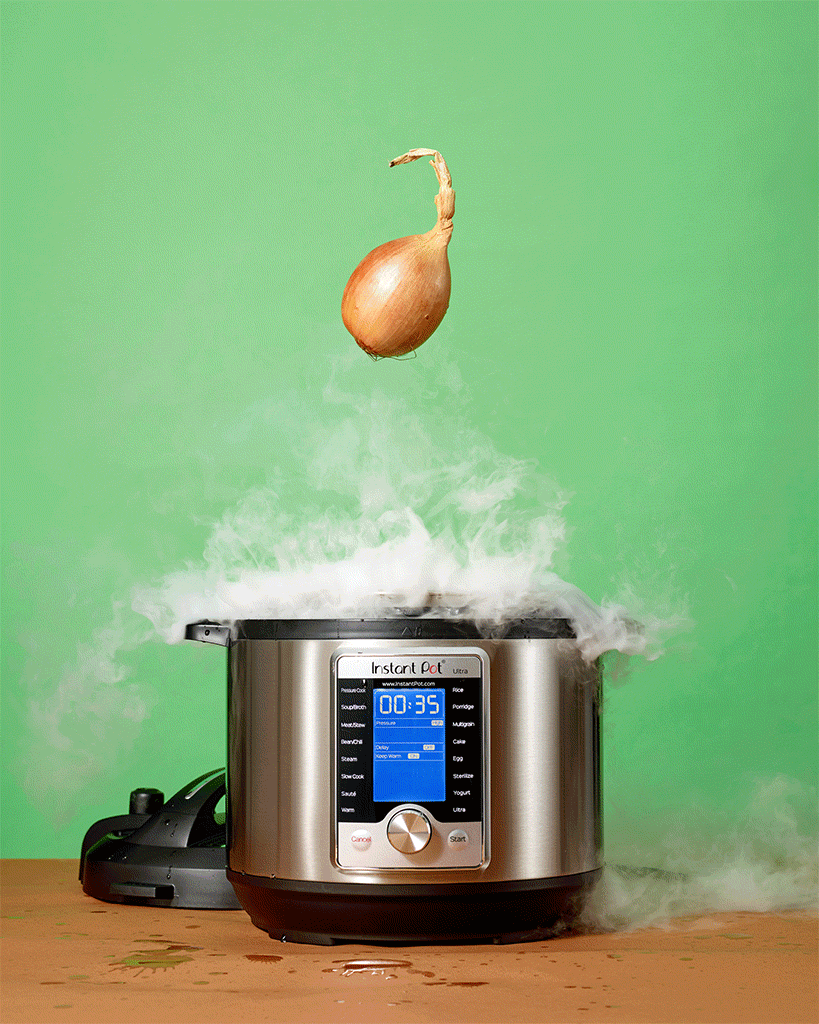本篇文章16635字,读完约42分钟
A Road Trip to Huangshan Mountain during the Spring Festival
Song Yuanming from Kinghelm
On the first day of Kinghelm's annual holiday, our family set off to the northeast and drove to Huangshan Mountain for a vacation road trip. My dad said we had worked hard for the past year and needed to relax. Work hard while at work and play hard after work as well. We decided to immerse in the hot spring first as we would have to pass the DiPai Hot Spring Hotel in Longmen, Huizhou on the way. When we arrived at the hotel, it was still a bit cold thanks to the rain, so we first tried the local cuisine at the hotel restaurant and had a short rest before heading to the hot spring. The hot spring pools are located outdoors. Although the temperature was relatively low, it was still pleasant to soak in the hot spring. There are many types of pools, including Yao medicine pools, red wine pools, and rice wine pools, with labels on the side introducing what each pool does for the body. So our family went to soak in one after another, albeit I could not feel any difference.
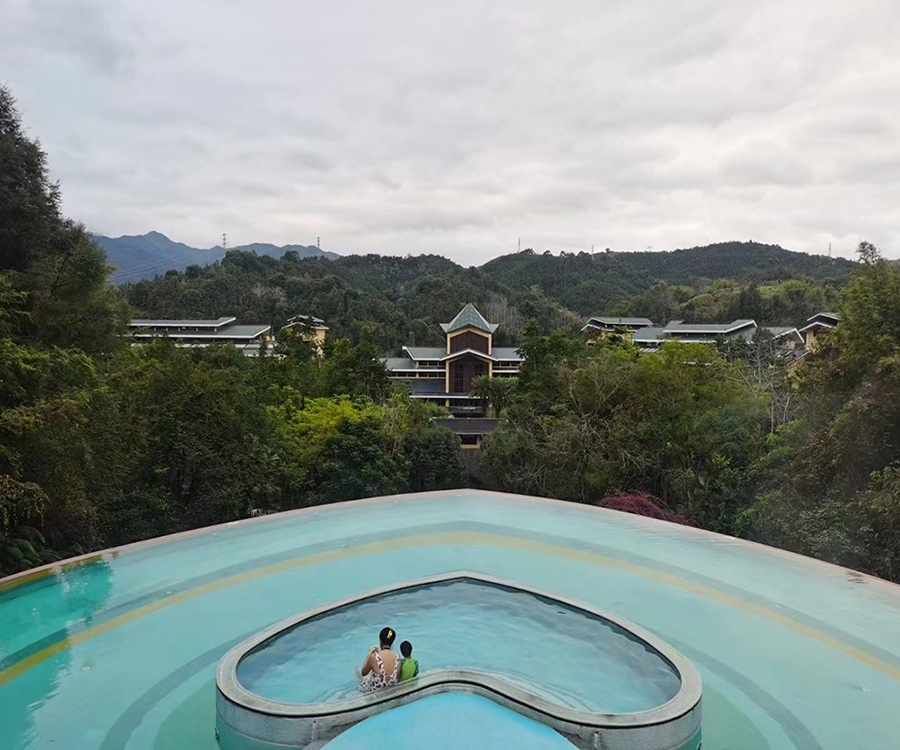
The elevated heart-shaped spa pool at the DiPai Hot Spring Hotel
After the hot spring, we went to the sauna, hoping to steam out all the cold air that we had accumulated outside. We felt a few kilos lighter after the sauna. Soon it was evening and we had dinner in the village next to the hotel. It was not as good as in the big restaurants, but the price was affordable with different flavors. I wondered if it was the low temperature or the period near the Lunar New Year. There were not many people in the village. We walked along the river for a while after dinner and went back to the hotel to rest.
After breakfast at the hotel in the next morning, my mum and dad went for a walk in the hills around the hotel. I reckoned I hadn't soaked enough in the hot spring, so I went back to my room to continue the hot bath. When my mum and dad returned, we packed our things and drove straight to Huangshan Mountain. We arrived at the Huangshan International Hotel in Tunxi at around 5 p.m. After a quick bite at the service area at lunchtime, we then continued our journey. We parked our car and tried some local Anhui cuisine. We first went to a restaurant next to the hotel but were told they didn't take in customers after 8.30 pm. So we picked up a tricycle and found a restaurant near Tunxi Old Street. The driver chatted with us on the way and said many shopkeepers had gone home on holiday because of the fast-approaching Chinese New Year. As there was an acute shortage of staff, the restaurants were closing early. My dad added that the shopkeepers close early in these third-tier cities, but the night was just beginning in developed cities like Beijing, Shanghai, and Shenzhen. The tricycle took us to a restaurant near the old street and we went in and ordered some Anhui specialties: Smelly Mandarin Fish and Fried Fermented Tofu. The Smelly Mandarin Fish had a little stinky smell yet it tasted delicious. The Fried Fermented Tofu had a similar flavor to our Sichuan Fermented Tofu, but it was much tastier. After dinner, our family went for a walk along Tunxi Old Street, where it housed many landmarks of the old Huizhou merchants, such as the horse-head wall, green tiles and white walls, and brick carvings. My father studied them for a while. But the shops in the street were closed. There was nothing to see apart from the old buildings. As the weather was particularly cold, we jumped into a taxi back to the hotel after watching the amazing night scenery by the lake!

Tunxi Old Street in Huangshan
We booked a suite in the hotel which set us back 2,680 yuan, the price for one night accommodation. When we first entered the room, it seemed quite luxurious, with a study and a meeting room. But when we took a closer scrutiny, the hotel facilities were particularly old and the bedroom even tripped when the lights were first switched on. So it didn't seem to be worth the while. My dad blamed me for this, citing that we should control the costs and spend on those things that were worth the money. So I decided to switch to 2 separate standard rooms the next day. We went to bed early as we had been driving all day long. The next morning we had breakfast at the hotel and left for Huangshan Mountain. On the way to Huangshan Mountain, we examined the route and decided to take the cable car from the back of the mountain, go all the way over Bright Peak, take the cable car from the front of the mountain, and then descend the mountain. Although the time was a bit tight, most of the attractions could be done in a day starting from the back of the mountain which would not be so tiring. My dad reiterated that everything should be prepared in advance, just like handling the work matters related to Kinghelm (www.kinghelm.com.cn) and Slkor (www.slkormicro.com). Do not engage in a war without any preparation.
After about an hour's drive, we arrived at the foot of Huangshan Mountain. Even though we were all wearing thick clothes, we could still feel the cold wind stinging as we got out of the car. Looking around, the mountain was white and snow-capped. But it was very beautiful. We parked the car, bought the tickets, took the bus straight to the Yungu cable car at the back of the mountain, and then queued to get onto it. Although it was particularly cold, there were still a lot of tourists. We had waited for almost an hour before we could get on the cable car. On the cable car we saw a particularly breath-taking snow scene halfway up the mountain. It emanated a different feeling from different angles despite having the same snow scene. After we got off the cable car, we walked all the way up the mountain path and arrived at Bright Peak. The snow scenery along the way was really mind-blowing. Each part of the route evoked a different set of feelings. Along the way, we also saw three of the four best features of Huangshan Mountain. Unfortunately, we didn't get to experience the hot springs. Luckily, we had just tried them at the DiPai Hot Spring Hotel.
Icicles on the hillside of Huangshan Mountain
Oddly shaped pine trees: Huangshan Mountain spans across hundreds of kilometers, with thousands of peaks and gorges, and pine trees are very common everywhere. The Huangshan pine is found in the high mountains above 800 meters above sea level, tenaciously rooted in the huge rock crevices. The needles of the Huangshan pine are thick and short, green and dense. These pines are rooted in different altitudes, some standing upright at the peak, some hanging upside down over the cliff, while some with a top as flat as a hat or sharp as a sword. Some bend along the cliffs or gullies, and some emerge from the crevices. Hanging, crossing, lying, rising across different altitudes, there was an old saying that "all trees are pines; there are pines on every stone; every pine has a strange shape." We saw the Black Tiger Pine and Unity Pine among the ten famous pines of Huangshan Mountain, while we missed the rest of the pines due to time constraints, which was really a pity.
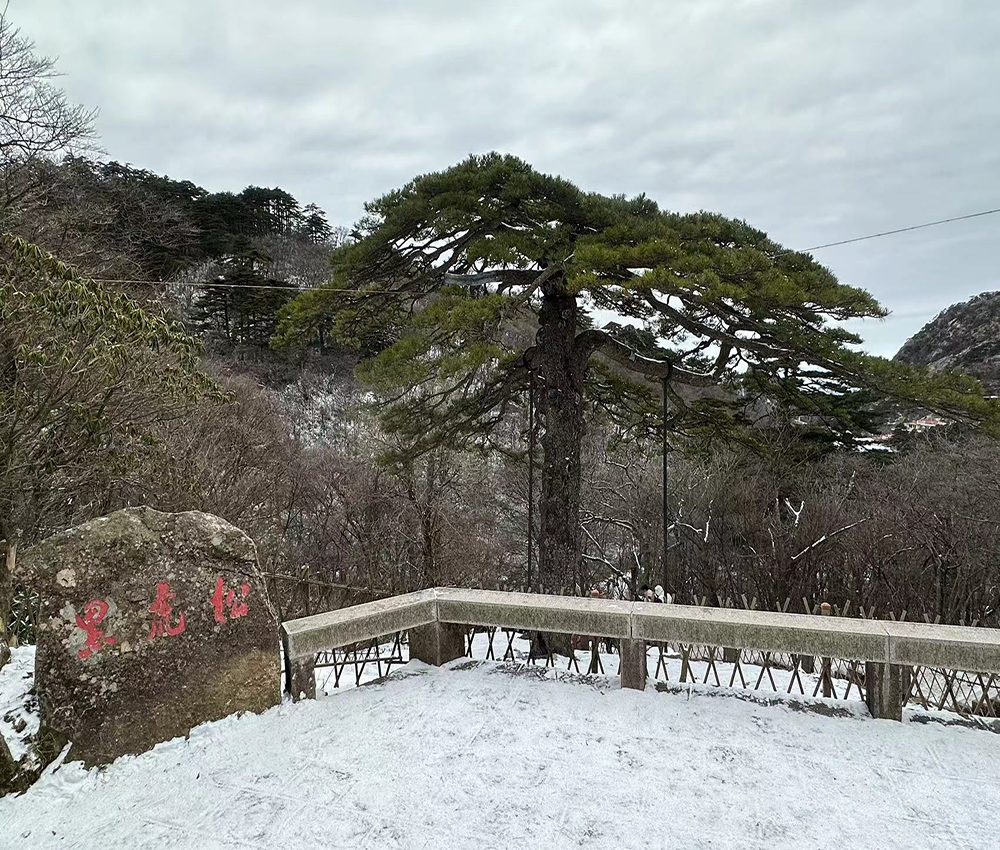
Black Tiger Pine
Odd rocks: Known for their oddity in persity, the shape of these rocks can be described as bizarre while amazing. Some look like people, some look like birds, and some look like animals. But they are different in a vivid way. When viewed from different positions or in different weather conditions, the strange rocks of Huangshan attract very different kinds of interest. They are scattered all over the mountain with some at the peak, some on the edge of the slope, some accompanied by pine trees, forming many natural mountain rock paintings. There are many strange rocks in Huangshan Mountain. There are four most peculiar rocks, of which we snapped pictures of “Dream-like brush penning a flower” (A mountain peak is like a big brush, and the ancient pine at the end of the brush floats like a flower) and “The monkeys overlooking the boundless sea” (The rock on the top of the mountain looks like a monkey crouching on the mountain and looking at the tumbling sea of clouds). It was indeed a pity as we could not take pictures of the other two with a tight schedule.
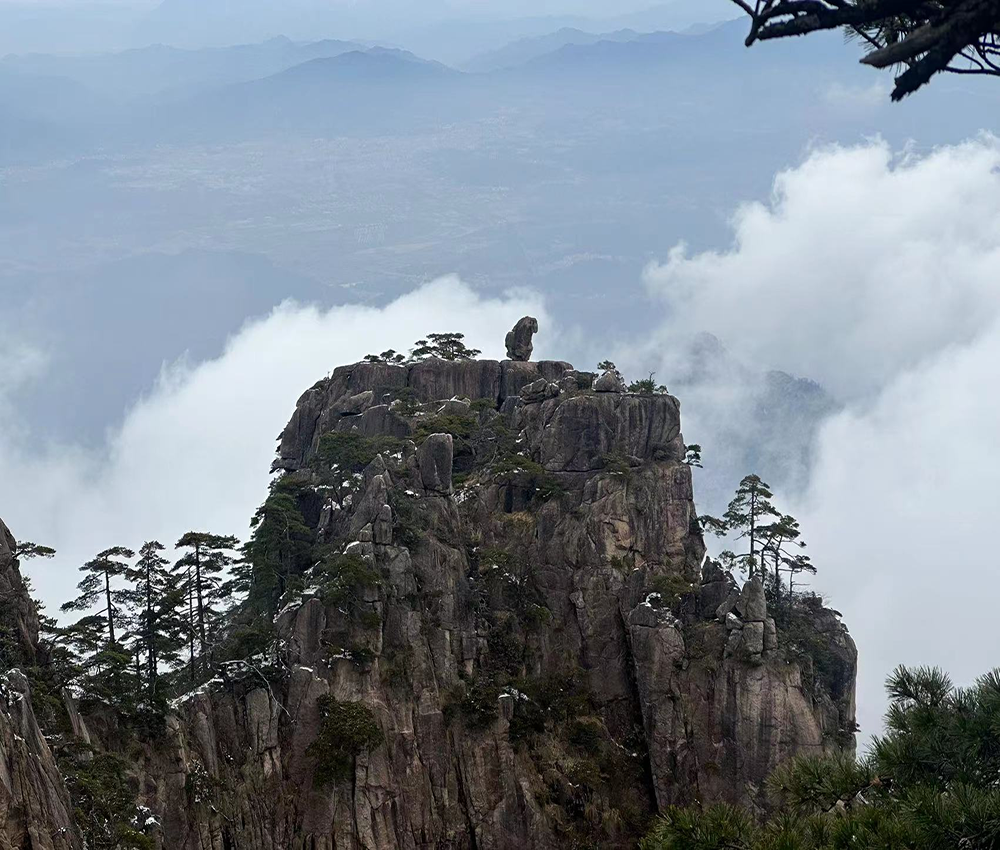
The monkeys overlooking the boundless sea
Sea of Clouds: Since the era of ancient times, the Sea of Clouds in Huangshan Mountain has been very famous. Huangshan Mountain is the home of clouds. The peaks resemble the body, while the clouds are akin to clothing. The magnificent and spectacular cloud sea is renowned for its beauty and fantasy, which can be seen all year round, especially in winter. According to the various directions of the cloud sea, there are east sea, south sea, west sea, north sea and sky sea in the entire mountain. When you climb up Lotus Peak, Tiandu Peak or Bright Peak, you can view all the seas in front of your eyes and enjoy the scenic landscape of "the sea ends in the sky and I am at the top of the mountain". On the way there, someone explained, saying that there are only 51 days a year when you can see the sea of clouds, and we were really lucky to see it today.
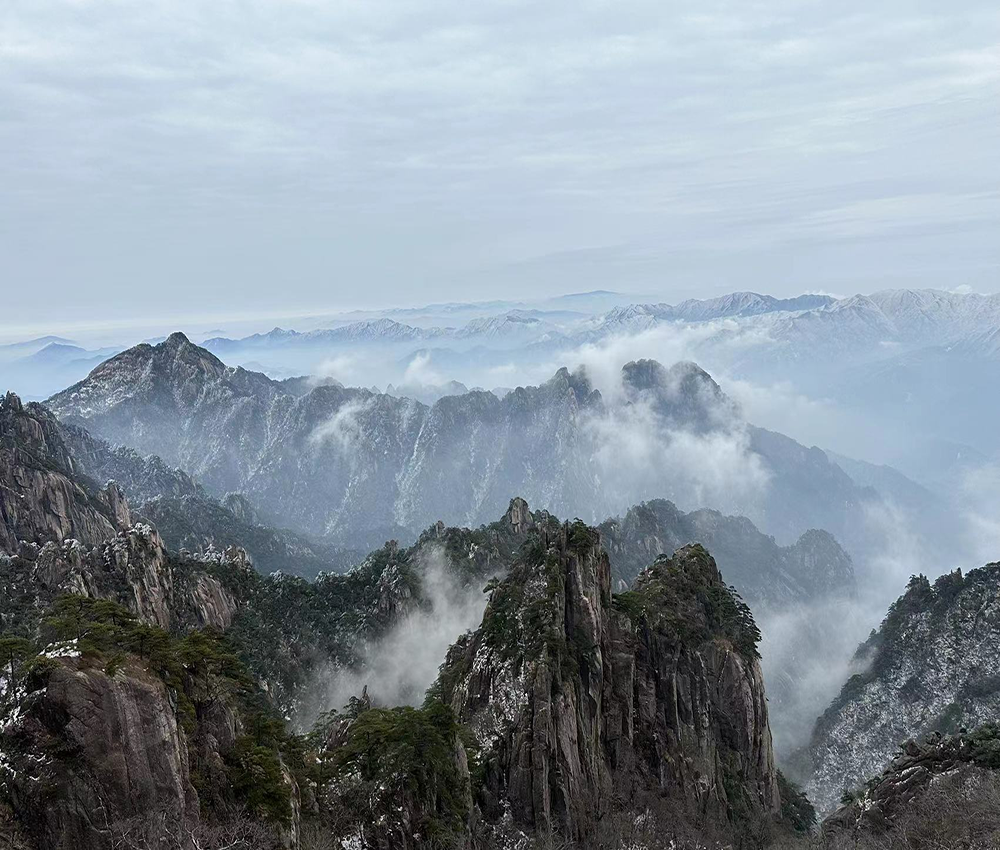
Sea of Clouds in Huangshan Mountain
We also made a detour to see the Beihai Hotel and the Xihai Hotel, which were much more aesthetic and decorated than the Huangshan International Hotel where we stayed. We checked the price of the hotel room there. To our surprise, it was only a little more expensive than the standard room at the Huangshan International Hotel. It was really a good deal. If not for the limited time we had, we would have stayed on the mountain for one night to watch the sunset and sunrise at Huangshan. Unfortunately, we didn't have time to see the Paiyun Pavilion, Xihai Canyon and Lion's Peak. As a result, we hurried down to Bright Peak.
Stairways of the Xihai Hotel
After descending from the mountain, we found a B&B for dinner. This B&B was very well decorated. My dad chatted with one of the staff and learned that the place spent more than 500,000 yuan on decoration alone. The white gourd shaped beam above the door was nearly obsolete because the old carving master has no apprentice. We ordered the pork ribs and heard the staff saying it was from their own pigs that were raised on grains. The ribs were very succulent, and the rest of the dishes were exceptionally flavorful. After dinner, we checked on the price of the B&B and found that it was also cheaper than the Huangshan International Hotel where we stayed. The surrounding ambience was also outstanding. My dad also added that the B&B industry around Huangshan is now following the mainstream trend more and more closely, and the local state-owned hotels will no longer be able to survive if they do not keep up with the times. The next day we needed to travel more than 10 hours to get back to Shenzhen. So after dinner we found a foot bath shop to relieve our fatigue legs. After the massage we drove back to the hotel. Back at the hotel, we moved to standard rooms, took a bath to soothe our tired bodies, and then rested in a deep sleep separately.
After a good night's rest, we planned to rush back to Shenzhen. But my dad thought we should instead visit Hongcun. It would be a shame not to visit the iconic place there. My father used to study ancient architecture as his profession with deep affection for this field. So we drove another hour or so to Hongcun. Located in Yixian County, Huangshan City, Anhui Province, Hongcun is a symbolic ancient village in southern Anhui. Famous for its paradisiacal idyllic scenery, well-preserved village form, exquisite craftsmanship of Huizhou-style dwellings, and colorful historical and cultural aura, it is known as "the landscape in Chinese paintings".
In my opinion, isn't Hongcun just another village? People say Hongcun is beautiful, ancient and civilised, has a long history and is mysterious. How can a village be so famous? When I visited Hongcun, the first thing I saw was a crystal-clear lake surrounded by countless old and flourishing banyan trees. The furnishings of the old houses in Hongcun are old, but full of ancient charm. In the old houses, the patterns on the beams are delicately carved, showcasing the prosperity and wealth of the olden days. We also happened to meet a couple of guides who were narrating about the history of the house to the curious tourists.
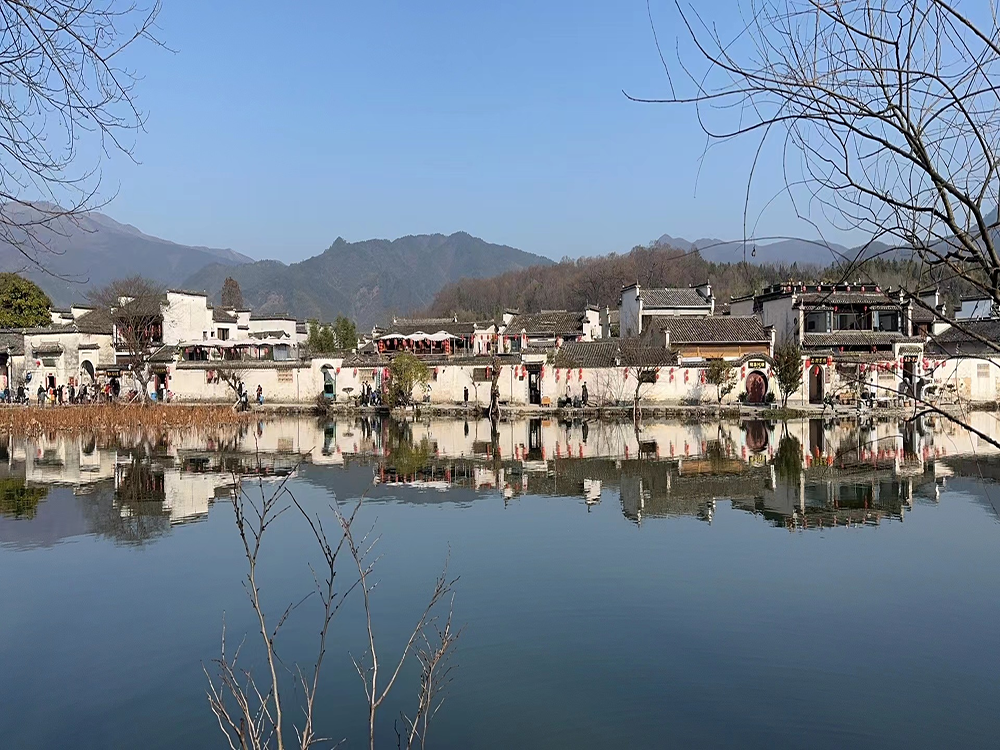
Crescent Lake in Hongcun
Leaving the old house, we walked along the path to the central square of the village. There are two old trees in the square, one a maple poplar, which the locals call it the red poplar, and the other a ginkgo tree, which the locals like to call it the white fruit tree. The red poplar is like a giant umbrella, encompassing several acres of fields from the entrance to the village. The village is shaped like a bull, thanks to two ancient trees that resemble a pair of bull horns. At the same time, these two ancient trees are also known as Hongcun Feng Shui trees, which symbolize good luck. Under the trees, there were many tourists taking pictures and many children playing and joking in a happy atmosphere. There are also many small shops around, including a small shop that makes fermented tofu snacks, which was once featured on "A Bite of China" and has now become a popular spot for internet influencers, with loads of tourists from all over the world taking pictures. I also stepped into the shop to watch the snacks being made and purchased one to satisfy my craving.
The antique teahouse of Kinghelm & Slkor
Time was limited. So we explored the village in a hurry. On the way, we saw a ditch under the stairway of every house with water flowing all the way to the lake at the entrance to the village. Initially, we figured it was a drainage ditch. But then we heard from the villagers that it was a fire ditch used to prevent fire outbreak. The village faces south. In ancient times, the people of Hongcun designed an ox-shaped village for fire prevention and irrigation of farmland, and built a unique series of artificial water systems. The layout of the village is symbolic with the Leigang Mountain as the head of the bull, the two ancient trees at the entrance of the village as the horns of the bull, and the houses lined up in the village as the body of the bull. In the center of the village there is a crescent pond called Moon Marsh, dug out in the shape of a crescent because of the symbolic meaning of "the flower is not yet blossomed and the moon is not yet full", akin to the stomach of a bull. To the south of the village is a man-made aqueduct called the South Lake, which is the belly of the bull. The canal that runs through the front door of each house is the bull's intestine. Finally, there are four old bridges in the village, which symbolize the four legs of the bull. As the saying goes, "the mountain is the head of the bull, the tree is the horn, the bridges are the four hooves and the house is the body". From the air, Hongcun looks like a giant bull lying among the green mountains and water. Why does such a design enable Hongcun to avoid flooding? The secret lies in exploiting the natural topographical differences. Hongcun has a vast difference in elevation from north to south. So it is possible to draw water from the Xixi River in the north and dig a canal that serves both irrigation and flood control. The canal was built at the entrance of each house. As the saying goes, "Although the water from the stream is far away, there is a clear spring in every doorway", it is considered to be the natural "tap water" used by the ancient people.
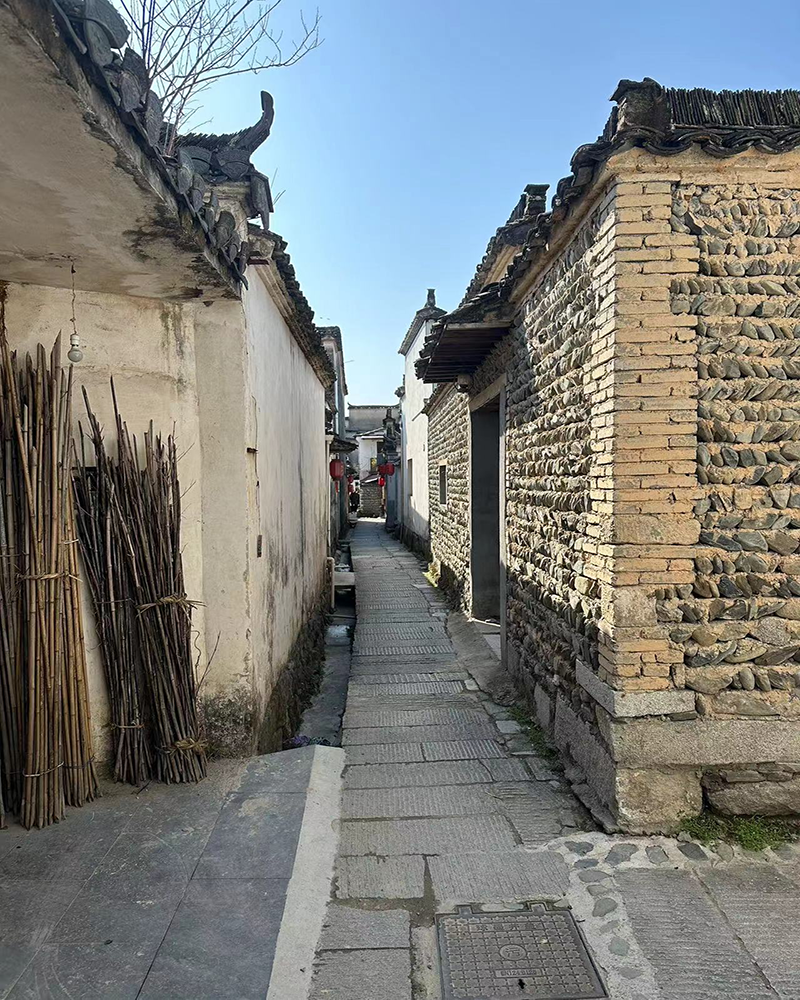
An Alley in Hongcun, Huangshan
We bought a small souvenir in the village shop and made our way back home. After more than 10 hours of driving, we were finally back in Shenzhen. During the trip, I not only enjoyed the beauty of viewing the country's great rivers and mountains, but also learned a lot that I think I could use them in my future work. I often hear people say, "Trips to China's five great mountains render the trips to other mountains unnecessary, and a trip to Huangshan renders the trips to the five great mountains unnecessary." It was pretty obvious that this trip was well worth it. Although I had some regrets over this trip to Huangshan due to the time constraint and the many landscapes I missed, it made me look forward to the next available trip! As the old saying goes, "It is better to travel ten thousand miles than to read ten thousand books". If it is possible, we also want to bring the Kinghelm (www.kinghelm.com.cn) and Slkor (www.slkormicro.com) colleagues over to view these picturesque landscapes themselves, broadening their narrow perspectives so that the company will improve on its soft strength and competitiveness!



